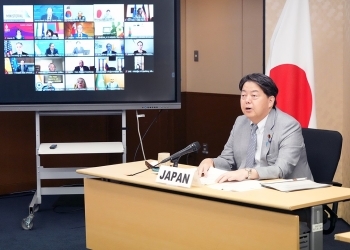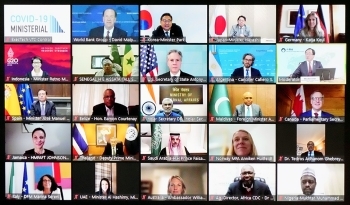Health and Medical Care
The COVID-19 Global Action Plan Foreign Ministerial Meeting co-hosted by the Minister for Foreign Affairs of Japan and the Secretary of State of the United States
July 19, 2022


On July 19, commencing at 20:30 (JST), Foreign Minister Hayashi Yoshimasa co-hosted the COVID-19 Global Action Plan Foreign Ministerial Meeting with the Honorable Antony Blinken, Secretary of State of the United States of America in an online format.
- In his remarks, Minister Hayashi reiterated the importance for the whole world to maintain and accelerate countermeasures to overcome the pandemic, and presented Japan’s contributions to ensure equitable access to vaccines through financial contributions to COVAX, dose donations, and its “Last One Mile” support. Minister Hayashi emphasized the importance of the GAP which facilitates information sharing and coordination on the ground to implement assistance to meet the needs of each recipient country. He stated that we have to address the fragility in governance and financing related to global health, and strengthen the foundations for better prevention, preparedness, and response (PPR) to future health crises. He also announced Japan’s decision to contribute seed-funding of 10 million USD to the FIF at the World Bank. Moreover, Minister Hayashi shared his intention to strengthen international partnerships for PPR in Africa at the 8th Tokyo International Conference on African Development on August 27-28 in Tunisia, and to actively contribute to strengthening the global health architecture as the host of the G7 Summit next year, toward the overall goal of achieving universal health coverage (UHC).
- Secretary Blinken emphasized that new variants continue to pose a risk to COVID-19 response and that the world’s work to end this acute phase of pandemic is not done, despite other demands and crises straining global attention. He called on GAP partners to continue advancing GAP lines of effort and to maintain high-level political attention on delivering concrete outcomes in advance of the United Nations General Assembly in September. Secretary Blinken also called on partners to improve coordination for, and equitable access to, vaccines and treatments, especially with an increased focus on the delivery of doses for boosters and increased demand and uptake for pediatric doses. Secretary Blinken urged participants to focus on the collective commitment to strengthen the global health security architecture to prevent and prepare for future health threats. He also emphasized the need to simultaneously combat other ongoing health threats, including HIV/AIDS, tuberculosis, and malaria that continue to claim lives and urged countries to contribute toward the Global Fund replenishment. Lastly, he thanked partners for their support of the new Financial Intermediary Fund established with the World Bank and World Health Organization and called on other countries to contribute.
- Participants joining Japan and the United States in the COVID-19 Global Action Plan Foreign Ministerial Meeting included the Argentine Republic, the Commonwealth of Australia, People's Republic of Bangladesh, Belize, Canada, the Republic of Colombia, the Republic of Costa Rica, the Federal Republic of Germany, the Republic of India, the Republic of Indonesia, the State of Israel, the Italian Republic, Jamaica, the Republic of Korea, the Republic of Maldives, the Kingdom of Morocco, the Federal Republic of Nigeria, the Kingdom or Norway, New Zealand, the Kingdom of Saudi Arabia, the Republic of Senegal, the Republic of South Africa, the Kingdom of Spain, the Kingdom of Thailand, the United Arab Emirates, the African Union/Africa Centres for Disease Control, Heads of the World Health Organization, and the World Bank. Through ministerial remarks and discussions, the participants identified the progress and remaining challenges, and reconfirmed their commitment to strengthen efforts across the COVID-19 Global Action Plan (GAP)'s six lines of effort: to get shots in arms, bolster supply chain resilience, address information gaps, support health care workers, expand access to testing and treatment, and strengthen the global health security architecture in collaboration with multilateral efforts.


